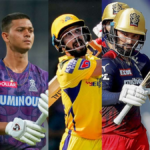Indian Premier League (IPL) has transformed cricket making it a global sporting spectacle. Moreover, despite the financial rewards and exposure, the impact of IPL on player development is in question. Is the IPL a staging ground for young stars or an interference from real cricketing skills? We will consider the issue of IPL’s influence on players’ career paths as well as its positive and negative effects. Unveiling the Champions: IPL Winners List 2024 Revealed!
A Launchpad for Talent: The Upsides of the IPL
Financial Security and Career Stability: Young cricketers receive financially secure contracts from IPL, which allows them to concentrate on playing without worrying about money. This is particularly helpful for those players who come from less privileged backgrounds enabling them to play cricket without worrying about their financial status.
Exposure to High-Pressure Environments: Youngsters are exposed to high-pressure cricket by participating in the entire tournament. This invaluable experience includes playing alongside international greats and against them. It helps them learn how to be among the best people and develop the necessary temperament as well as skills that are required to be successful at this level.
Case Study: The Jasprit Bumrah Story
Jasprit Bumrah’s meteoric rise is unmatched by any other phenomenon about scouting talent through examples of IPL. For instance, before the 2013 season, nobody had heard about him more than probably as some fast bowler or even an average one. However, his outstanding performance for Mumbai Indians made him known globally and enabled him to interact with legends such as Lasith Malinga. This experience fast-tracked his development process turning him into a world-class speedster. Stay updated with live IPL cricket scores (Baap of IPL) today.
Mentorship and Coaching Opportunities: World-class coaches are available in this league, where experienced players also mentor young talents. They help fine-tune techniques; orientate strategies and build mental sturdiness hence speeding up the development of a player.
Case Study: The KL Rahul Transformation
KL Rahul’s journey epitomises the significance of coaching and mentorship in IPL. This turning point came after a few average seasons when he moved to Kings XI Punjab (now Punjab Kings) under coach Anil Kumble’s guidance. It was an experience that helped Rahul redefine his technique, tweak shot selection and develop inner strength. His 2018 season saw it pay off with him ending as the highest run-scorer of the tournament.
A Platform for Skill Development and Innovation: The fast-paced nature of T20 cricket encourages batsmen to develop innovative strokes and bowlers to experiment with variations. Through this highly competitive league, young players can showcase these techniques while at the same time refining their own game.
Case Study: The Rise of Wrist Spinners
The rise of young wrist spinners like Kuldeep Yadav and Yuzvendra Chahal has been witnessed in IPL. Their skills have been honed in this competition under tutelage from experienced spinners including Anil Kumble and Piyush Chawla. Consequently, they have learned how to vary pace, flight or even deception making them successful internationally under high-pressure situations.
The Potential Pitfalls: Challenges in the IPL
Over-emphasising T20 skills and disregarding traditional cricket can have negative repercussions on an individual player’s Test development. Workload management is key to preventing burnout and career-ending injuries. IPL Betting Tips: Elevate Your Betting Game to the Next Level!
Case study: Hardik Pandya’s Dilemma
Hardik Pandya is a typical example of such a case which highlights the issue of workload management. His blistering batting and medium-pace bowling make him an asset to any T20 side. Nonetheless, his involvement in Test matches has been limited by recurring back problems related to excessive workloads. For players like Pandya, juggling IPL demands with long-format skill acquisition remains a major challenge.
Selection strategies that lack consistency and are short-term oriented
Case study: The Prithvi Shaw Paradox
Prithvi Shaw is talented. However, his IPL exposure has lacked consistency. Constant changing often affects young players’ confidence and prevents them from finding their groove.
Getting the Balance Right: Optimizing the Impact of the IPL
Balancing between pros and cons inherent in the IPL will be essential for maximizing its positive influence on player development:
The focus should be on skill development across formats
IPL teams need to refocus their efforts on developing comprehensive skills-based programs for all members at all levels, working in conjunction with BCCI. These programs develop young cricketers’ skills in areas such as building an innings, bowling long spells or fielding techniques hence creating all-rounded cricketers.
Efficient workload management systems must be established
Some effective measures of dealing with such issues include data-based analysis, communication between franchises, BCCI as well as International teams and prioritizing fitness over everything else so that players may remain healthy throughout the year
Case study: Australia’s Model
Australian Cricket Board provides a good example whereby this approach has worked successfully for them in the past years.
They also require enough rest for effective training and skills adaptation needed in different formats.
Creating long-term vision and development plan for players
Franchises need to have a long-term vision, rather than merely focusing on the immediate needs of the game. Sponsoring gifted youth, giving them equal chances and mentoring programs can help to create future talent.
Holistic approach
For instance, there should be mentorship programs that do not only focus on mental toughness but also financial management and general health that would enable these young stars to cope with life as professional cricketers positively.
Conclusion: IPL – A Force for Good Managed Responsibly
The IPL has the potential to be a powerful force for good in developing players. By taking into account these negatives as well as incorporating responsible management practices, the true essence of the IPL can become one that facilitates many young talents in becoming all-round cricketers who can perform excellently in any format of cricket. Striking this delicate balance is key to the future of Indian cricket, meaning that it is necessary to ensure that the IPL empowers players, rather than becoming an obstacle to their development. As fans, we need to actively get behind teams that prioritize player growth and call for a comprehensive approach towards nurturing cricketing talent at the IPL level. Please bear in mind that IPL not only entertains but also serves as an investment for Indian cricket’s future. Let us strive for not just superstars but also holistic cricketers with adaptability beyond generations.







